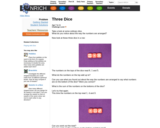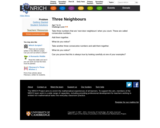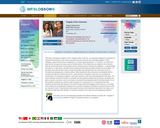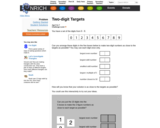
Students explore combinations in this Nrich activity. There is a simulator to help students with visualizing the possible outcomes. Discussion is a key element.
- Subject:
- Mathematics
- Material Type:
- Activity/Lab
- Date Added:
- 05/31/2021

Students explore combinations in this Nrich activity. There is a simulator to help students with visualizing the possible outcomes. Discussion is a key element.

This Nrich problem encourages children to explain observations and to generalize. It requires a good understanding of multiplication. It may also introduce the idea that opposite faces of a dice add to seven, if that is something with which learners are not already familiar

This Nrich problem supports the development of the idea of generic proof with the children. This is a tricky concept to grasp but it draws attention to mathematical structures that are not often addressed at primary school level.

This lesson introduces students to the “Tragedy of the Commons,” an extended metaphor for problems of shared environmental or man-made resources that are overused and eventually depleted. In this metaphor, shared resources are compared to a common grazing pasture, or “commons,” on which any dairy farmer can graze as many cows as he/she wishes. If too many cows are added to the commons, they will overeat the grass in the pasture and the shared resource will become depleted – a disadvantage to everyone. In this lesson, students will be inspired to think about possible solutions to this problem. To get there, they will use basic math to frame the problem and will discover how useful this can be in considering consequences of various actions. Most importantly, they will become comfortable with the concept of problems of shared resources – and will learn to recognize, and seek out, examples all around them. An exposure to algebra 1 and basic functions is the only math prerequisite necessary. The lesson will take around 50 minutes to complete and the required materials for this lesson are paper and pens or pencils, as well as some sort of prize to provide the winning team with in the final activity. For all five activities, students are asked to work in groups of 4, but groups of 3 or 5 would also be okay. Students will work with their groups to discuss the logic behind the tragedy of the commons, to consider some options for preventing this tragedy and to examine examples of problems of shared resources that are relevant to them. They will also come up with functions that fit behavior described in the video, and be asked to think about the behavior of functions provided in the video and accompanying materials.

This Nrich problem is a fantastic opportunity for learners to apply knowledge of place value and offers a context for learning and practicing the relevant vocabulary (odd, even, multiple). The interactivity will help learners satisfy their curiosity in the sense of finding a 'better' solution, as it enables them to play around with the digits without having to commit anything to paper. This act of deciding whether one solution is better than another also provides a meaningful context in which to compare and order numbers.

This Nrich investigation is one that uses the very popular multilink cubes. It gives a wonderful opportunity for pupils to explore ways of recording. This activity is also designed to nurture children's curiosity by introducing mathematics into a familiar non-mathematical context. Children might end up pursuing different ideas from each other and this freedom to explore may well encourage learners to persevere more than they might usually. In this way, they will immerse themselves in the particular number sequence they have chosen to use, which will help them gain a deep understanding of its structure. This activity lends itself to pupils posing their own questions in the form “I wonder what would happen if...?”